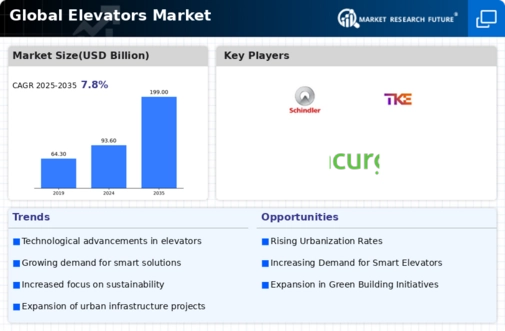Market Share
Elevators Market Share Analysis
The migration of a large and growing population from rural areas to established cities has increased the need for infrastructure development, including high-rise buildings and infrastructure, to accommodate the emerging population. The UN Department of Economic and Social Affairs estimates that 60% of the world's population will be urban by 2030, exceeding the 2028 figure. This figure is projected to reach 68% by 2050, driving elevator industry demand from 2021 to 2030. Companies use several market share positioning methods to stand out in the ever-changing elevator market. A key approach is elevator technology and design innovation. Companies engage in R&D to improve energy efficiency, speed, safety, and smart connection. Companies may attract clients looking for contemporary, efficient residential, commercial, and industrial elevator systems by providing cutting-edge solutions. Elevators market share positioning depends on pricing tactics. Cost leadership firms provide elevator systems at low costs to attract budget-conscious customers. Alternatively, firms that emphasize luxury, technology, or safety use premium pricing methods. This premium strategy targets clients that appreciate high-end elevators, increasing profit margins and value. A large distribution network is essential for market share positioning. Companies work with architects, builders, and owners to make their elevator systems widely available. A well-organized distribution infrastructure strengthens market reach and makes these materials easier to obtain for construction planning and upgrades. Accessibility influences buying choices, so organizations position themselves to fulfill demand. Strategic agreements and cooperation with construction and real estate companies are also important for elevator market share positioning. Companies may exchange knowledge, reach new markets, and solve elevator installation and integration issues by partnering with developers, property managers, and architects. Joint ventures, strategic acquisitions, and collaborations boost a company's Elevators Market share and position. Effective marketing and branding are key to market share growth. Through digital marketing, industry events, and construction professional involvement, companies build brand awareness and promote their elevator systems. A well-known brand draws new clients and creates confidence among architects, developers, and building owners, strengthening a company's elevator solutions market share. In the elevator sector, innovation drives market share positioning. Companies invest in R&D to create innovative elevator products that meet design, sustainability, and user needs. Eco-friendly materials, innovative control systems, and space-saving designs may make a firm a pioneer in elevator solutions. Market share positioning also depends on customer-centric tactics. Company elevator systems and services are tailored to building owners, architects, and facility managers' demands. Quality customer service, customisation, and safety compliance generate confidence and long-term connections. Customer satisfaction increases recurring business, improving a company's reputation and market share.






Leave a Comment